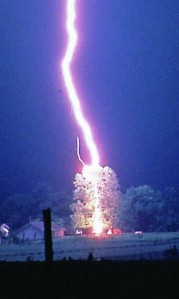Fire from the Heavens in Early Medieval Ireland December 26, 2010
Author: Beach Combing | in : Medieval , trackbackBeachcombing has been cursing his internet provider today that has managed, with characteristic incompetence, to deprive the Beachcombings of their connection to the world wide web – no joke when you live in a rural idyll and make most of your phone-calls by skype.
In any case, Beachcombing will do his best to smuggle this out on a pen-drive to tell the world about the Tallaght Movement (aka the Culdees), an early medieval Irish Christian group famous for its learning, its uncompromising spiritual life and its unusual relationship with lightning.
Any kind of human relations with lightning – other than sensible fear – might at first sound strange. But lightning has always had a special role in the Christian tradition. Seen as one of the instruments of God’s wrath, it was known to the Church Fathers (via the classical tradition) as ‘fire from the heavens’.
St Michael, the Archangel of war, was said to use it. And, across the medieval world, though especially among Celtic-speaking peoples, special shrines were built to Michael with lightning in mind.
Churches or hermitages were dedicated to the Archangel high on cliff-sites or coastal islands with a simple logic. It was there that lightning was most likely to strike and it was there that the hermit could come closest to God’s divine anger.
In Ireland the most famous ‘elemental shrines’ are the Skelligs off the coast of Cork. Whereas in the lands of the British Celts St. Michael’s Mount in Cornwall and Mont St Michel in Brittany also attracted the faithful.
Beachcombing once had a close encounter with lightning – a terrifying experience – and is bewildered to think of medieval Christians repeating the Lord’s Prayer, say, as they felt that characteristic buzz form in the air around them.
Scholars know that the Tallaght Movement was interested in lightning because in their writing Tallaght authors refer regularly to ‘fire from the heavens’. And the daily life of monks in the Movement included constant prayers to the archangel Michael. Michael and lightning – nature, at its most terrifying – proved useful symbols for the Movement’s muscular version of Christianity.
Their religious life was extremely strict. They constantly criticised the ancient monasteries of Ireland – Armagh, Clonmacnoise and others – that they believed to be corrupt. While those Irish men and women who did not meet the Movement’s high standards – the vast majority – were dismissed as ‘sons of death’.
This aggressiveness matched with an interest in lightning may explain one of the most mysterious sentences ever written in Irish. On 20 November 772 AD a special meeting was held. In the words of the Annals of Ulster ‘the Assembly of the Hand-clapping [took place], at which occurred lightning and thunder like the day of judgement. The hand-clapping on St Michael’s Day which called forth fire from the heavens’.
The Assembly of the ‘Hand-clapping’ has long puzzled Beachcombing: what can it possibly mean?
Well, hand-clapping usually signifies lamentation in medieval Ireland.
As to the fire from heaven, there is no definite proof that the Assembly was connected to the lightning-mad Tallaght Movement. But the evidence is suggestive.
First, the council was held on the feast of St Michael, a favourite day of the Movement.
Second, the members of the council were full of woe. Again this corresponds with the Tallaght Movement that continually criticised a sinful mankind.
Third, in this period, the Movement was involved with another council that is recorded in the Irish Annals – so an assembly would be in character.
Then, fourth and finally, there is the ‘fire from the heavens’ that interested the Movement.
If a council had come together to bemoan Ireland’s spiritual condition, then it is quite likely that lightning, the instrument of St Michael’s wrath, on St Michael’s feast, would have been taken as a sign of divine approval. There is even the intriguing possibility that the hand-clappers prayed for and got lightning – according to the Annals of Ulster those who attended ‘called forth’ the fire. Or was this a later gloss?
Beachcombing would be interested in any other attempts – Christian or otherwise – to harness lightning in the Middle Ages: drbeachcombingATyahooDOTcom



